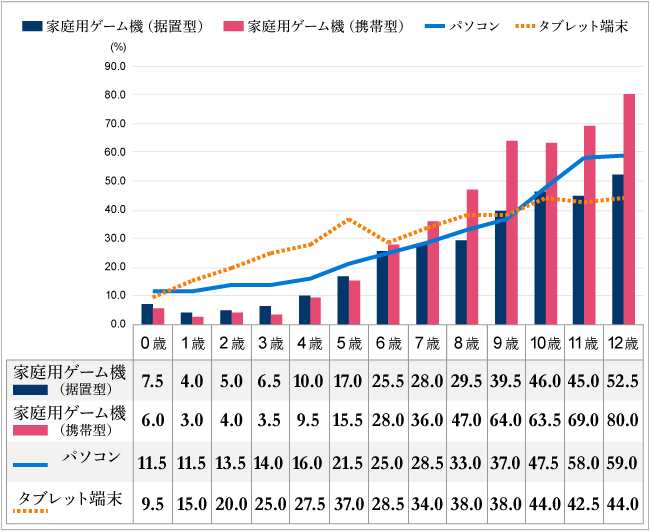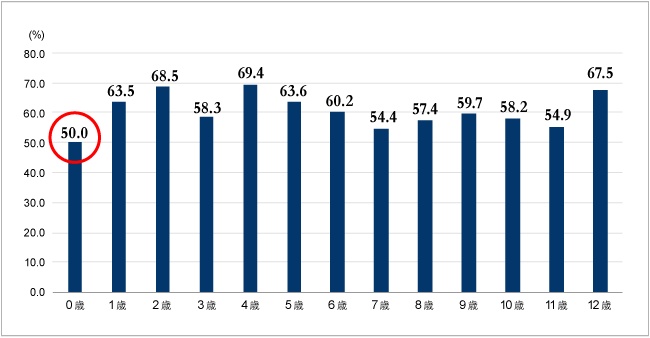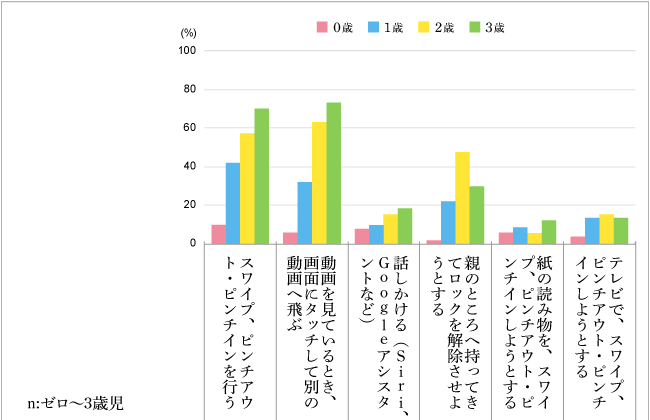電通メディアイノベーションラボでは、東京大学大学院情報学環の橋元良明教授と共同で子どもとメディアの関わりについて研究を続けています。このたび、共同研究チームでは、乳幼児のスマホ利用を中心テーマに据え新たな調査を行いました(2018年7~9月:母親に聞く形でのウェブ調査、およびグループインタビュー)。今回のインサイトメモでは、その結果から見えてきたファインディングスをご紹介します。
なんと、0歳児の23%もがスマホを利用している!
図1は、0歳~12歳児の母に対する「お子さまはスマホを利用していますか?」という質問の結果です。ご覧の通り、生まれたばかりの0歳児でも23.0%がスマホに接触していることが分かりました(自宅内での利用)。この23.0%という数字、橋元教授が行った別の調査でもほぼ同値(23.5%)という結果だったそうです(橋元研究室&KDDI:2017年9月調査)。今やスマホは、「乳幼児から普通に触れられるもの」となっているようです!
(参考まで図2でスマホ以外のデジタル機器接触率も掲載)

【図1】子どもの年齢別スマホ接触率(%)

【図2】スマホ以外のデジタル機器接触率(%)
乳児がスマホを使うようになったワケは?
では、スマホ乳児台頭の背景について考察します。なぜ、乳児がスマホに触れるようになったのでしょう?その「いきさつ」「背景」として、以下の3点ほどが感じられました。
①母親層におけるスマホ利用の浸透
②忙しい子育てや家事の中で、スマホが「子守り」のツールとして使われ始めた
③乳幼児にとって、スマホは「最高のおもちゃ」となりつつある
まず①ですが、例えば今から10年前の母親たちはスマホをほとんど使っていませんでした(日本へのiPhone 3G 導入は2008年)。一方、昨今ではほとんどのお母さんがスマホを利用しています(今回の調査では0~6歳児の母の9割以上が利用という結果でした)。
②に関しては、“ワンオペ育児”で忙しい毎日の中、ついついスマホに子守りを頼ってしまうというお母さんたちの様子を、わたしたちはグルインの生声から知りました。例えば、以下のようなコメントが聞かれています。
“家事で忙しいとき、子どもにスマホを渡してしまう。たまには自分自身のご飯をゆっくり食べたい、と思うときとか…”
“病院・電車などの公共の場で子どもを静かにさせるためにスマホの画面を見せたのがキッカケかな”
“寝かしつけのオルゴール代わりにスマホを使い始めた。「赤ちゃん 眠る」などと検索すると、そういう感じの曲が流せる”
このようなトレンドは今後も拡大してゆくのでしょうか。
乳児はスマホで何をしているのか?
「スマホが子どもの最高のおもちゃとなっている」という件(③)ですが、では彼らはスマホで何をして遊んでいるのかというと、多くの乳幼児がYouTube(子ども向けのYouTube Kids含む)を見ています。例えば、図3に示す通り、スマホ接触のある0歳児の2人に1人はYouTubeを視聴しています。1歳児以降はさらに高い接触状況です。親の手を引っ張ったり、親へ向かって「アンパンマン!」と言い続けるなどして、スマホを見たいとせがむのだそうです。
ちなみに、グルインでお母さんから聞かれた逸話ですが、アンパンマン動画の見られない古い機種を手渡すと泣きだしてしまうという子もいました。(注:アンパンマン動画といっても正確にはアンパンマンの人形を使って遊んでいるたぐいの映像が主)。その他、キャラクターが歌う動画を見せると子どもが泣きやむ、とか、動物の映像、玩具の紹介動画が好き、といった話も聞かれました。

【図3】子どもの年齢別YouTube接触率(母数:スマホに触れている子)
動画視聴以外のおもちゃ的利用としては、スマホの「カメラ機能」も乳児たちのお気に入りです。0~1歳くらいでは、親が撮った自分の写真や動画を見るのが大好きな子が多く、1歳児では自分が撮られた画像を「見たい!」としゃべったり、自撮りをしたりする子さえ現れています。その他、知育目的で、「子どもへスマホでクラシックを聴かせている」とか、「フォニックス(英語の綴りと発音の関係性をもとに、正しい読み方の学習を促進させる手法)関連の動画を見せている」といったケースも見られました。
子どもとメディアの今後
現代の乳幼児は、画面を指で触れることによりデバイスを操作する〔タッチスクリーン族〕になりつつあります。次の図4をご覧ください。


【図4】子どもがスマホ・タブレットで行っていること(母数:0~3歳のスマホ/タブレット利用者)
0~3歳児のタッチスクリーン習熟度ですが、細かい年齢まで刻むとサンプル数は少なくなるものの、1歳児の42.0%がスマホ・タブレットでスワイプしたり、ピンチアウト・ピンチインといった2本の指で画面を拡大縮小する動きを行い、32.1%は画面にタッチして別の動画へ移動するというような操作を体得しています(テレビの画面をスワイプ・ピンチアウト・ピンチインしようとする子さえも!)。※母数はスマホorタブレット利用者。
こうしたデータを見ると、「見たいコンテンツは、指一本、自分主導でチョイスする」という感覚を当たり前とした子どもたちが、これからますます増えていくことが予想されます。自己都合メディア主義…とでも呼びましょうか。
また、(これは4歳児以上への質問結果からですが)テレビの大画面での視聴が楽しいと感じる一方、スマホによる好きなタイミング・場所での視聴にも魅力を感じているという傾向も見られました。今後の子どもたちでは、メディアの器(=視聴デバイス)へのこだわりが少なくなっていき、プラットフォームフリー感覚が拡大してゆくことが予見されます。
さて、共同研究者の橋元教授は次のように述べられています。
“今回の調査により、スマホが乳児にもまさに普及しつつあるこの時期にしか得られない貴重なデータを得ることができました。例えばテレビの普及期において、乳幼児を対象にした同種の量的調査というのは日本に存在しません。テレビを導入したとき、0歳児も興味を持ったのか、どのような番組を好んだのか、親はどのような懸念をいただいたのかなどのデータがあれば、さぞ興味深いものになったと思います。”
生まれた時からスマホが空気や水のように当たり前の環境として存在する世界で育っていく子どもたちを、共同研究チームでは「ポストデジタルネイティブ」とネーミングしました。今後、ポストデジタルネイティブが長じるに従い、彼らが大画面で見るテレビリアルタイム視聴とスマホ動画視聴をどのように利用し分けていくのか、映像コンテンツに対する嗜好自体が従来の世代とどのような変化をとげるのか、実証的に追跡調査すべき課題は山積しています。
【定性調査概要】
(1)調査手法:オンライン調査
(2)調査日:2018年7月14日(土)~16日(月)
(3)対象:ネット調査モニターから下記の条件該当者をランダムに抽出
「長子」の年齢が0歳~12歳(中学生を除く)までの子どもをもつ20~49歳の母親
(4)対象エリア:全国
(5)有効回収サンプル数と割付:
【定性調査概要】
(1) 調査手法:グループインタビュー調査
(2) 調査日:2018年9月4日(火)
(3) 対象:①0~2歳児(性別問わず)の子を持つ母親(6名: 20~44歳)/母親自身が自分専用スマホを保持、かつ、子がほぼ毎日YouTubeを見ている
②小学5~6年生女子の母親(6名:20~44歳)/子は自分専用のスマホを1年以上持ち、ほぼ毎日そのスマホを使い、かつ、LINE, Instagram, Twitter, Facebook のいずれかを利用している
(4)対象エリア:一都三県在住
(5) インタビュー参加者数:6名×2グループ(①と②)
お問い合わせ先:
(株)電通 電通メディアイノベーションラボ
長尾 嘉英















